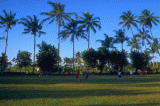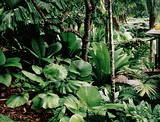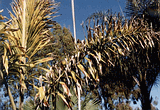Palm Species That Show Rapid Growth
by Phil Bergman
Information about certain species of palm trees that are generally accepted as fast growing. Article discusses multiple species with descriptions of each.


Introduction
Gardeners and enthusiasts are often looking for fast growing trees. We at Jungle Music, of course, would like to promote fast growing palm trees. There are certain species of palm trees that are quite fast growing. This is important because many enthusiasts wish to establish an overhead canopy by planting faster growing palms and thus giving some protection for the more delicate understory species. Canopy offers a warmer environment nearer the ground, can protect from hot sun, and to an extent can help maintain humidity near ground level. For this reason, hobbyists often start with fast growing species. This also provides palms that trunk rapidly so you get the feeling of being in the rain forest before too many years.
I must first define what is meant by fast. Fast means rapidly growing compared to most other species in the palm world. This equates to a species that can quickly get overhead and eventually and relatively quickly be among the tallest palms of the garden. Of course, growth rates vary with localities. In general, the more tropical the growing environment, the quicker a given species will grow. With any given species, a grower in Queensland, Australia will grow a palm more quickly than someone in Miami. And that Miami grower will grow faster than someone in Southern California, and those with very little summer heat will grow at a much slower rate than someone with continually warm weather. As we are in Southern California, I am listing species that can be grown here. In Hawaii, Clinostigma species are very fast and would prove to be a canopy former. This genera can be grown here, but would not be typically thought of as a “canopy forming” plant. Given these restrictions, however, there are species that are known to be extremely fast growing in Southern California. Be aware that you must follow cold hardiness recommendations (another article at this website) and apply these limitations to your choices. Despite growing rapidly during the summer, if a plant is killed or set back during a cold winter’s night, very little has been accomplished in terms of establishing height or canopy in the garden.
The following is a list of commonly available palm tree species that would be considered fast growing. Comments are made about each genera or species. Growth rates apply to conditions seen in the coastal area of Southern California, as that is where we have obtained most of our growing data. As you review the plants below, realize that many of these species could be used to establish canopy for your garden, but be careful in selecting the best species for your particular locality.


Wodyetia bifurcata.
EXAMPLES OF FAST GROWING PALMS

Archontophoenix cunninghamiana
The common King Palm is a quick growing palm. It loves rich soil, lots of nutrition, and ample water. You can get a 15g plant up to 25 feet in about 10 years or a bit longer. If given partial sun, they seem to stretch (out of competition for sun) and grow a bit faster. I have seen as much as 12 inches of trunk height between the leaf nodes on some of my well grown King Palms. They definitely are a good canopy-forming tree. Eventually maximum height is about 40 feet.
Archontophoenix species, other:
Almost any of the Archontophoenix species are quick growing and make great canopy palms. They are all beautiful and can grow about the same rate as the King Palm if grown well. A. maxima and A. myolensis are particularly beautiful, even more so than the King Palm, according to most observers. A. beatricea is known to have prominent steps on the trunk rings and a bulging base. Archontophoenix purpurea has a unique lilac color to the crown shaft.

Carpentaria acuminata: Is a fast growing species, lives in South Florida, but in Southern California is average speed at best. It is an Australia species with a relatively thin trunk. Due to its sensitivity to cold, it is not used as a canopy forming palm here in California. It can survive, but not attain the same 30 plus feet obtained in more tropical areas

Caryota gigas:This species, called the black trunk or King Kong palm is also quite rapid growing, but not as fast as C. urens. It seems to establish trunk girth before it puts on vertical height. But, it eventually does get very tall. It is also a very husky species with a trunk that is bigger in diameter than Caryota urens. Some feel that its girth almost approaches the diameter of Jubaea chilensis. As this is a relatively new species, its not clear how tall this palm will grow in a domestic garden here in California, but it will probably get over 80 feet. Enthusiasts like this species because it has huge horizontal leaves, a very thick trunk, and beautiful sculptured leaflets.

Caryota urens:
This common fishtail palm is extremely fast. It can go from a 15 gallon plant to well over the house with thirty feet of size in five to seven years in rich garden soil with lots of nutrition. Some growers hear have had specimens grow to well over sixty feet. This species, like all Caryotas, is monocarpic and will eventually die when the tree flowers. This takes about 20 to 25 years. The trunk diameter is typically about 18 to 24 inches. This species will outgrow any other palm in your garden.
Caryota species, other:
There are other species such as C. ochlandra, C. cumminghii, C. no, and others that are quite rapid growing. None are as quick as C. urens. Surprisingly, Caryota mitis, the suckering species, is not a particularly fast grower and should not be counted upon for establishing canopy.

Euterpe edulis:
This one is fair as a canopy former and has a fairly good growth rate, although not real fast. One can get a 20 foot plant in ten to fifteen years. It is very thin trunked and has a decorative long crown shaft. It can tolerate some frost.

Ravenea rivularis:
Although a species with some drawbacks, the Majesty Palm is indeed a fast grower. Well grown, one can have ten feet of trunk in about ten years. It seems to look better if grown in partial day sun rather than full day sun. My best specimen is now about thirty-five feet tall in 20 years and gets full morning sun. This species is very dependent on nutrition, water, and an ample supply of microelements, especially magnesium. It has difficulty growing close to the ocean, perhaps because of the salt in the ocean air

Syagrus romanzoffiana:
Queen Palms are also quite fast growing. This species is one of the most commonly used species of palm trees. They are not as fast as Caryotas, but can get up to 25 feet from a 15 gallon plant in about seven to ten years. They respond to good nutrition, soil and lots of water. Trunks of the queen palm are smaller than those of Caryota urens, but the crown is comparable or a little bit smaller than the common fishtail palm. They are also reasonably cold hardy. The tallest Queens I’ve seen are about sixty feet from the ground to the top of the crown.
Syagrus species, other:
Such species as S. oleracea, S. sancona, and a few others are quick growers and have potential for canopy formation. These other species of Syagrus tend to be harder to find at most nurseries. Well chosen, they can add to establishment of an effective canopy.

Roystonea regia (and other Roystonea species):
Royal palms are moderately fast growers, although not typically as fast as those species above in our locality. One can obtain an overall height of about 20 to 25 feet (from a 15g plant) in 10 years if the species is well grown and doesn’t see significant cold weather. They like heat, full sun, and good water and nutrition. The most popular characteristic of this species is the fat, swollen trunk base. Everyone likes to stand at this species base and slap the trunk, appreciating the “watermelon sound” emitted from such a spanking. Care must be taken if you are subject to hard freezes in your locality, as Royals don’t take much below 26 to 28 degrees F.

Washingtonia robusta:
Although not typically thought of as a canopy-forming species, this fan palm is quite a fast growing tree. It is particularly fast with continual warm climates as is seen in the inland areas of Southern California. The drawback to its being an ideal canopy-forming species is the small volume of the leaf crown. One can overcome this by planting multiple plants together in a clump. It can easily get ten feet of trunk in ten years from a 15g plant if grown properly. This species is readily available in most areas of Southern California. It does require trimming of old leaves or it will develop the petticoat along its trunk. It is fairly cold hardy and tolerates hot desert sun.

Wodyetia bifurcata:
This species is sort of fast, but not a rocket. It likes heat, sun and can tolerate a bit of cold weather during the winter. It is thin trunked and in Southern California doesn’t make as large a crown of leaves as you would see in the tropics. I would only consider it a fair canopy former. Along the Coast, it doesn’t seem to grow as fast as it grows inland with more heat. Known as the Foxtail Palm, this species is becoming quite popular and will find a place in most gardens.
SUMMARY:
The above are all reasonably fast or very fast growing palms. All should be considered when you want to establish vertical height in the garden or get canopy above. Listed above are many fast growing trees. Howeas, Bismarkia, Rhopalostylis, Pritchardia, Burretiokentia, Dypsis species and many others can be used for establishing canopy, but these latter genera are not known to be particularly fast growing. There are some shade loving species that are quite fast growing, but obviously would not be used to establish canopy. This list might include some Chamaedoreas, certain Dypsis, Synecanthus, and a few others. But, in forming canopy with a fast growing palm species, one is better off choosing from the species listed above. Be careful to check on cold hardiness for your area. If it will grow for you, give some of these species a try.
- PALM TREES, CYCADS & TROPICAL PLANT BLOG - October 1, 2020
- TRACHYCARPUS
The Windmill Palm - September 30, 2020 - FAN PALMS –
PALMS WITH CIRCULAR LEAVES - September 29, 2020











